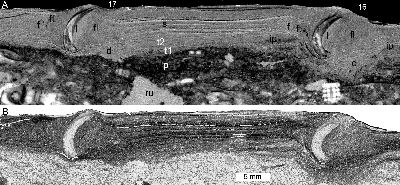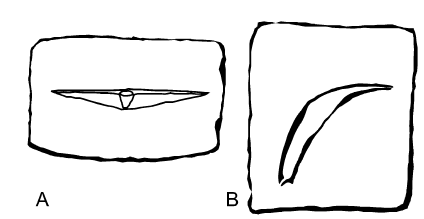
Welcome to the Xfossils.com Wish List. If you would like to contribute to the Wish List, send a description and, optionally, pictures, to wishlist@xfossils.com
Item #5: Posted Tuesday, September 21, 2004
Name: Ben Dattilo
Email: dattilob@unlv.nevada.edu
Subject: Strophomenids found in a vertical position, hingeline down.I recently described a slab containing 20 specimens of Sowerbyella rugosa from northern Kentucky between Cincinnati and Maysville. What was unusual about these slabs was that the brachiopods were situated vertically in the sediment, hinge-line down, unsupported by their neighbors. There is no way around the conclusion that the brachiopods got themselves into this unlikely position, so it represents some sort of life or escape position.
This is important because strophomenids were not supposed to have pedicles and should not have been able to move much at all, much less orient themselves vertically. Now that I have documented this behavior in Sowerbyella, I would like to document it in other similar dish-shaped or related brachiopods (strophomenids) like Rafinesquina, Strophomena, Leptaena, etc.
I believe that there are such specimens out there, because in 1929 a similar report was made: specimens of Rafinesquina minnesotaensis were found in the sediment, oriented vertically, with the hinge-line down. These are not the “shingled” Rafinesquina where each individual is leaning on its neighbor, but individuals that are separated from each other. Apparently nobody paid any attention to this early paper, and I have been unable to relocate the specimens.
My guess is that such specimens would only be found under conditions of rapid burial by silt or mud. The same conditions would tend to preserve whole trilobites and articulated crinoids. Preferably the specimens would not be cleaned, as I would get the most information by sectioning them in their original sediment.
Cross section through two specimens of Sowerbyella rugosa showing vertical position and disturbed sediments.
Drawing from earlier report (Sardeson, 1929) showing Rafinesquina in a similar position.IF YOU HAVE ANY SPECIMENS FITTING THIS DESCRIPTION, PLEASE CONTACT....
Benjamin F. Dattilo
Geoscience Department
University of Nevada Las Vegas
Las Vegas, NV 89154-4010
Phone: 702-895-1753 (Changed!)
Fax: 702-895-4064
dattilob@unlv.nevada.edu
Item #4: Posted Monday, January 19, 2004
Name: Mark Erickson
Email: meri@stlawu.edu
Subject: In situ colonies of ramose BryozoaI am interested to learn of sites at which I may study and collect well-developed ramose bryozoan colonies, preferably attached to their original dwelling substrate and encased in shale. Transported colonies preserved in shale are also of interest. Colonies should be substantial in size -- 25-30 cm and upward in height -- in order to have reached sufficient age to be useful for functional morphologic and taphonomic study.
Site information will be confidential within the limits of scientific disclosure. Collection and preparation will be necessary, but I would prefer to do these myself or that it be done in presence of me or my colleagues.
Colonies already collected and reconstructed are of interest if stratigraphic information is known. Collaborative research on this material would be welcomed.
Locations in the mid to upper Fairview and the Bellevue Fms., or in the Waynesville through Whitewater interval would be of particular interest. Unpicked sites are most desired so that surface material may be reconstructed onto excavated colonies.
Mark Erickson
Geology Department
St. Lawrence University
Canton, NY 13617
meri@stlawu.edu
Item #3: Posted Wednesday, March 13, 2002 6:20 PM
Name: Jon Branstrator
Email: jonb@earlham.edu
Subject: SeastarsI am resuming my work on seastar fossils from the Cincinnatian, with special interests in paxillose genera with strap-like arms (such as Urasterella). Most fossil seastar specimens are quite fragmental, but they usually show more important characteristics than near complete ones. Any lead on such fossils would be appreciated. I would likely ask to borrow, carefully prepare and study specimens, and that particularly significant ones be donated to the collections of the Cincinnati Museum of Natural History. Of course I will identify, to the best of my ability, all specimens that I work on.
Jon Branstrator
Professor of Geosciences
Earlham College 132
Richmond, IN 47374
jonb@earlham.edu
Item#2: Posted Saturday, June 09, 2001 9:12 AM
Name: Lee.Chiu Nan
Email: chiunan@netvigator.com.tw
Subject: SinohybrosaurusClick here for photos of S. lingyuanensis from Taipei Lee
Goodday Sir.
This is a new found fossil in China 1999
This specimens is Sinohydrosaurus lingyuanensis juvenile_A New Genus and New Species of Lepidosaurs in Lingyuan, Liaoning, China .
The below is the brief introduction about the precious reptile fossil:
It looks like a nothosaur. After detailed observation, however, the fossil from Lingyuan shows great differences from the nothosaur, mainly in the osteological structure, preserved environment and geological time as well. Lingyuan reptile has no clavicles, but has T-shaped interclavicle. It dived in fresh water in the area volcano of of Late Jurassic.
Base on the osteological structure, the reptile from Lingyuan should belong to Lepidosaurs. It is similar to lizards except its long neck. In the neck, there are 18 vertebra. Therefore it presents a new genus and new species. We name it as Sinohydrosaurus lingyuanensis. This species shows some filiation to living monitor lizards.
This Sinohydrosaurus lingyuanensis is rarer than mesosaur and Keichousaurus.These specimens all came from famous bird fossil layer of the Northeast China.And These specimens were?formed by volcanic ash and the slabs are thin.So unavoidably,most of the specimens were repaired by the binder.
Sinohydrosaur looks like a nothosaur that Keichousaurus belong to ,but it was early Cretaceous fossil.(125 million years ago).Before the Sinohydrosaurs was found,the scientist supposed this kind animal was extinct in the late Triassic period(225 million years ago).So when the Chinese scientists found this kind fossil,they were shocked!!!
The Sinohydrosaur came from the famous bird fossil layer of the Northeast China.The scientific value is very high ! The Keichousaurus can not compare with Sinohydrosaurs.
Regards
Taipei Lee
Click here for some photos of S. lingyuanensis from Taipei Lee
Item#1: Posted 12/06/2000 5:47 pm EST
Name: Dr. Joseph Carter
Organization: University of North Carolina at Chapel Hill
Title: Professor of PaleontologyI am looking for Ordovician and Silurian lamellibranch (bivalvian) shells preserved as replacement casts in dark colored (brownish or blackish) calcite. This kind of preservation has a good chance of preserving relict shell microstructures, which I study. If you know of a locality with such preservation, please let me know! I already know of one in the Southgate Member of the Kope Formation near Carrollton, KY, thanks to Bill Heimbrock. Thanks! - Joe Carter
Email: clams@email.unc.edu
Phone: 919 962-0685
Address:
Dr. Joseph Carter
Department of Geological Sciences
UNC
Chapel Hill, NC 27599-3315


